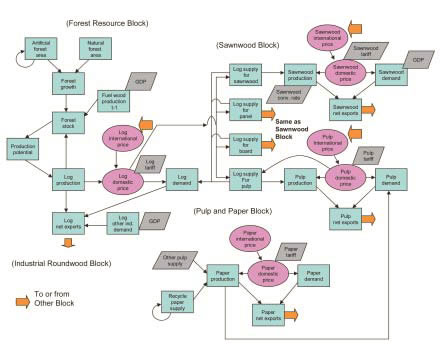Development of the World Forest Products Model
Description
[Objectives]
The preservation of forest resources is a critical issue in forest product trade negotiations. Many countries have analyzed the potential effects caused by liberalizing the trade of forest products on the natural environment based on the quantitative models. In this study, a project team composed of researchers from JIRCAS and the Forestry and Forest Products Research Institute developed a global quantitative model, with a particular emphasis on Pacific Rim countries in order to analyze how the reduction of tariff rates would affect the forest product markets and the sustainability of forest resources.
[Results]
The model, termed the "World Forest Products Model (WFPM)," is a comprehensive, yet practical model that forecasts the influence of trade and environmental policies based upon the previous leading world forest models, such as the GFPM (Global Forest Products Model) of the FAO or the GTM (Global Trade Model) of the IIASA (International Institute for Applied Systems Analysis). The WFPM is a simultaneous equation model using the same structure of the International Food Policy Simulation Model, created by JIRCAS, whereas these other models are based on mathematical programming.
The characteristics of the WFPM are as follows: 1) a partial equilibrium model focused specifically on forest products; 2) a multi-products model determining equilibrium prices of products that relate to each other simultaneously; 3) a multi-country or regional world model forecasting trade activity among regions; 4) a dynamic model using lagged variables to forecast time-series changes; 5) a synthetic model employing parameters estimated in other models; and 6) a policy simulation model analyzing the effects of policy changes such as the change of tariff rates.
The WFPM analyzes the following six products: round wood for industrial use, sawn wood, wood-derived panels, boards, pulps and paper. The data incorporated into the model include yearly time-series data that are aggregated from the FAOSTAT database. The model handles thirty-five regions and countries. Fig. 1 displays the structure of the WFPM.
The effects of tariff rate changes on supply and demand were tentatively measured during a sensitivity test of the model. In this case, the tariff rates were placed at zero for 2005. From the model, it was determined that few price changes occur at the world level (from -0.5 to 2.4%), for tariff rates are already at low rates. However, considerable effects on demand were discerned in the industrial markets, although product and regional effects vary substantially.
Figure, table
-
Fig. 1. Structural chart of the World Forest Products Model (WFPM).
- Classification
-
Technical B
- Term of research
-
FY2002 (FY2000-2002)
- Responsible researcher
-
KOYAMA Osamu ( Development Research Division )
FURUYA Jun ( Development Research Division )
OKA Hiroyasu ( Forestry and Forest Products Research Institute )
TAMURA Kazuya ( Forestry and Forest Products Research Institute )
- ほか
- Publication, etc.
-
Koyama, O., Furuya, J., Oka, H. and Tamura, K. (2002): Development of World Forest Products Model (WFPM). JIRCAS Working Report, 27, 1-47 (in Japanese).
Oka, H., Tamura, K., Tachibana, S., Kanomata, H., Koyama, O. and Furuya, J. (2002): Analysis of Forest Resource Sustainability by World Forest Products Model. Abstracts of Annual Conference of the Japanese Forest Economic Society, 256-265 (in Japanese).
Oka, H., Tamura, K., Tachibana, S., Koyama, O. and Furuya, J. (2003): Analysis of the Sustainability of the World Forest Production by the World Forest Products Model. Proceedings of the 114th Annual Conference of Japanese Forestry Society, 616 (in Japanese).
- Japanese PDF
-
2002_03_A3_ja.pdf821.49 KB
- English PDF
-
2002_03_A4_en.pdf60.93 KB

